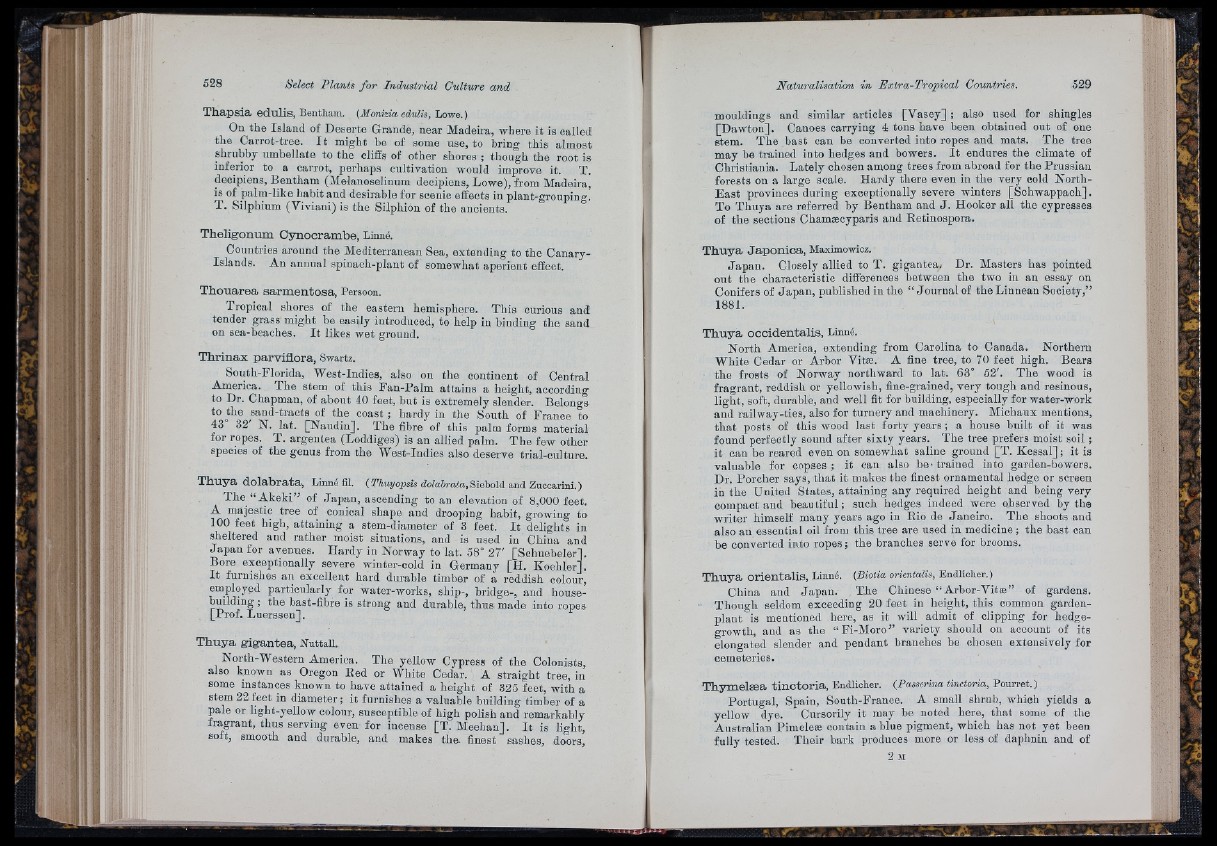
II
Thapsia edulis, Bentham. (Monizia edulis, Lowe. )
On the Island of Deserte Grande, near Madeira, where it is called
the Carrot-tree. I t might be of some use, to bring this almost
g ru b b y umbellate to the cliffs of other shores ; though the root is
inferior to a carrot, perhaps cnltivation would improve it. T.
decipiens, Bentham (Melanoseliuum decipiens, Lowe), from Madeira,
is of palm-like habit and desirable for scenic effects iu plant-grouping.
T. Silphium (Viviani) is the Silphiou of the ancients.
Theligonum Cynocrambe, Linné.
Conntries around the Mediterranean Sea, extending to the Canary-
Islands. An annual spinach-plant of somewhat aperient effect.
Tbouarea sarmentosa, Persoon.
Tropical shores of the eastern hemisphere. This curious and
tender grass might he easily introduced, to help in binding the sand
on sea-beaches. I t likes wet ground.
Tbrinax parviflora, Swartz.
South-Florida, West-Indies, also on the continent of Central
America. The stem of this Fan-Palm attains a height, according
to Dr. Chapman, of about 40 feet, but is extremely slender. Belongs
to the sand-tracts of the coast ; hardy in the South of France to
43 32 N. lat. [Naudin]. The fibre of this palm forms material
for ropes. T. argentea (Loddiges) is an allied palm. The few other
species of the genus from the West-Indies also deserve trial-culture.
Tbuya dolabrata, Linné fil. ( Thuyopds dolabrata, Siebold and Zuccarini. )
The “ A k ek i” of Jap an , ascending to an elevation of 8,000 feet.
A majestic tree of conical shape and drooping habit, growing to
100 feet high, attaining a stem-diameter of 3 feet. I t delights in
sheltered and rather moist situations, and is used in China and
Jap an for avenues. Hardy in Norway to lat. 58° 27' [Schuebeler],
Bore exceptionally severe winter-cold in Germany [H. Koehler].
I t furnishes an excellent hard durable timber of a reddish colour,
employed particularly for water-works, ship-, bridge-, aud housebuilding
; the bast-fibre is strong and durable, thus made into ropes
[Prof. Luerssen].
Tbuya gigantea, Nuttall.
North-Western America. The yellow Cypress of the Colonists,
also known as Oregon Red or White Cedar. A straight tree, in
some instances known to have attained a height of 325 feet, with a
stem 22 feet in diameter ; it furnishes a valuable building timber of a
pale or light-yellow colour, susceptible of high polish and remarkably
fragrant, thus serving even for incense [T. Meehan]. I t is light,
soft, smooth and durable, and makes the. finest sashes, doors.
i j]
mouldings and similar articles [Vasey] ; also used for shingles
[Dawton]. Canoes carrying 4 tons have been obtained out of one
stem. The bast can be converted into ropes and mats. The tree
may be trained into hedges and bowers. I t endures the climate of
Christiania. Lately chosen among trees from abroad for the Prussian
forests on a large scale. Hardy there even in the very cold North-
E a st provinces during exceptionally severe winters [Schwappach].
To Thuya are referred by Bentham and J . Hooker all the cypresses
of the sections Chamoecyparis and Retinospora.
Tbuya Japónica, Maximowicz.
J ap an . Closely allied to T. gigantea. Dr. Masters has pointed
out the characteristic differences between the two in an essay on
Conifers of Jap an , nublished in the “ Journal of the Linnean Society,”
1881.
Tbuya occidentalis, Linné.
North America, extending from Carolina to Canada. Northern
White Cedar or Arbor Vitæ. A fine tree, to 70 feet high. Bears
the frosts of Norway northward to lat. 63° 52'. The wood is
fragrant, reddish or yellowish, fine-grained, very tough and resinous,
light, soft, durable, and well fit for building, especially for water-work
and railway-ties, also for turnery and machinery. Michaux mentions,
th a t posts of this wood last forty years ; a house built of it was
found perfectly sound after sixty years. The tree prefers moist soil ;
it can be reared even on somewhat saline ground [T. Kessal] ; it is
valuable for copses; it can also be-trained into garden-bowers.
Dr. Porcher says, that it makes the finest ornamental hedge or screen
in the United States, attaining any required height and being very
compact and beautiful; such hedges indeed were observed by the
writer himself many years ago in Rio de Janeiro. The shoots and
also an essential oil from this tree are used in medicine ; the hast can
be converted into ropes ; the branches serve for brooms.
Tbuya orientalis, Linné. (BioUa orientalis, Endlicher.)
China and Japan. The Chinese “ Arbor-Vitæ” of gardens.
■ Though seldom exceeding 20 feet iu height, this common garden-
plant is mentioned here, as it will admit of clipping for hedge-
growth, and as the “ Fi-Moro” variety should ou account of its
elongated slender and pendant branches be chosen extensively for
cemeteries.
Tbymelgea tinctoria, Endlicher. {Passerina tinctoria, Pourret.)
Portugal, Spain, South-France. A small shrub, which yields a
yellow dye. Cursorily it may be noted here, th a t some of the
Australian Pimelese contain a blue pigment, which has not yet been
fully tested. Their bark produces more or less of daphnin and of
2 k